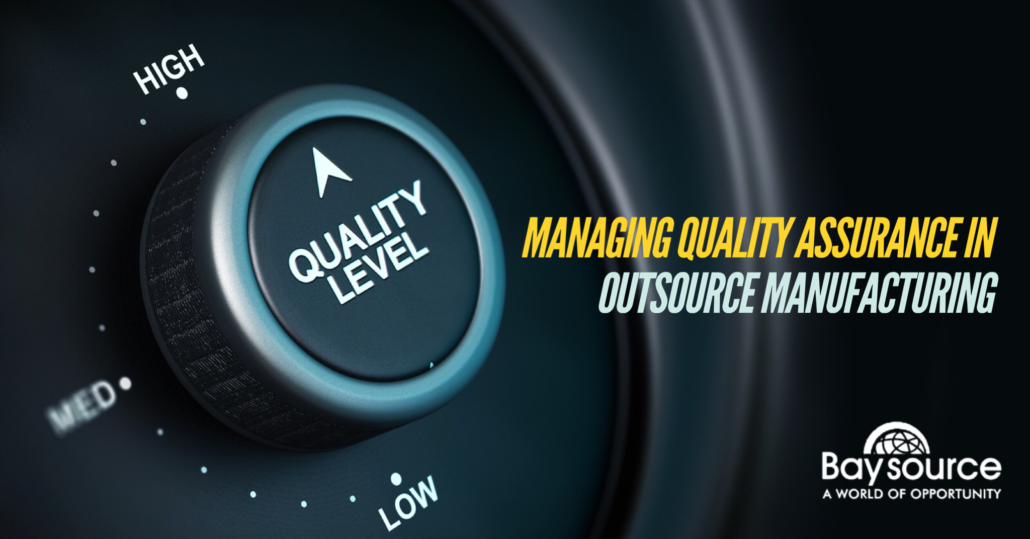Quality assurance in outsource manufacturing is one of the most challenging yet most important processes for the client to control. Often products manufactured overseas are stereotyped for having poor quality. Most of the time bad quality is the result of badly managed production. Whether cost-cutting by the manufacturer, a lack of training at their facility or no structured QC/QA plan in place, the ultimate responsibility falls on the brand. While the contract manufacturer is managing production the company and brand should have a prominent role in maintaining the integrity of its product.
A large majority of U.S. brands outsource some portion their manufacturing overseas. It should be no surprise why some companies continue to dominate with high-quality products while others struggle to maintain the integrity of their brand. Those that take accountability for corrective actions are able to maintain a higher standard of quality and can avoid increased costs caused by product defects.
What is Quality Assurance?
There is a common misconception that quality assurance and quality control are synonymous terms. However, they involve two different processes, each with their own best practices and guidelines. Quality control refers to the testing of products for functionality and form. It is the last checkpoint a product goes through before and even after shipments are received. Quality assurance is the processes in place before, during and after manufacturing that addresses the product conforms to company standards. Quality assurance is designed to proactively mitigate problems and defects downstream and is constantly refined.
The process used by the contract manufacturer should include a rigorous quality assurance program for finished goods. Quality problems in manufacturing are often caused by a lack of quality assurance measures or by poor execution and accountability. While most contract manufacturers adhere to standard quality assurance, companies should put in place their own practices to communicate expectations with their manufacturer.
What is AQL testing?
When manufacturing products en masse, defects and quality issues may arise. However, it is not efficient or cost-effective to carefully test each individual product for factory defects. This is why companies use Acceptable Quality Limit (AQL) testing to choose whether a product batch should be accepted from the manufacturer or denied.
Using this method, a sample of the total order and based on the percentage AQL, the manufacturer can determine whether an order is acceptable by the total defects found. Typically, an accept to point and reject point is established based on the AQL percentage and level of inspection (whether expect a very high quality is expected or if there is room for product variance).
This formula is created to help both client and manufacturer reach agreements in quality control and quality assurance standards. Determining the AQL before signing with a contract manufacturer can help establish a better working relationship.
Addressing Quality Assurance and Quality Control with overseas manufacturers
Getting involved early on with the selection of a contract manufacturer is the best way to address QA/QC. Audit potential partners to understand their QC programs. How are they staffed? Are they certified to any international standards? Ask for documentation (most suppliers proudly display these certificates on their walls). Ask for an example of something that went wrong and how they addressed it. There are many different methods of ensuring quality products, but finding a manufacturer with a solid reputation and a policy of transparency when it comes to communications and quality assurance is important. To set quality assurance expectations from the beginning of the relationship, find a manufacturer that will:
- Create a list of quality attributes and get their agreement to adhere to company standards
- Allow onsite inspections
- Collect QA data and make corrective actions to improve production quality
Contract manufacturers of merit will ensure client needs and expectations are met, and will not shy away from asking and answering questions on quality assurance. Companies should include these expectations in their contracts at the start of the professional relationship. Making periodic inspections, and course-correcting through corrective action is suggested.
How to manage logistics without getting overwhelmed
Logistics can become problematic when working with an overseas manufacturer. Language and communication barriers, time zone differences and unpredictable timelines can cause logistics complications for companies who have never contracted work overseas. Transparency is the single most important value to the relationship between manufacturer and client. Companies can communicate with and hold manufacturers accountable for following these rules:
1. Thinking from the manufacturer’s perspective.
Outsourcing overseas means the manufacturer and client will be communicating through different languages and time zones (China is 12 hours ahead of U.S.). Nonetheless, the production timeline should be communicated at the beginning, with these factors in mind. Many overseas manufacturers will have an English-speaking team that is available 24/7, but if this is not the case companies should prepare with their own team or sourcing agent to bridge the gap.
2. Audit and collect data to improve logistics.
Companies should play an active role in auditing and researching their manufacturers’ logistics. Auditing can help both parties spot areas for improvement, and facilitate communication and understanding between them. Each player in the supply chain, from suppliers to manufacturers and distributors should be kept in-check for quality assurance.
3. Know what each country’s documentation and customs.
Transport of large orders across borders can be a hassle for the client company. To ensure a smooth process, U.S. companies should educate themselves on the documentation and customs requirements in each country their goods will pass through, so there are no surprises at the first shipment.
Working with a sourcing agent can help manage logistics and ensure quality standards are met. An outsourcing partner can help facilitate communications with overseas partners and manage client projects for maximum efficiency. If a company chooses to manage projects and oversee quality assurance themselves, they must always communicate with the manufacturer and use AQL best practices during product testing.


Follow Us